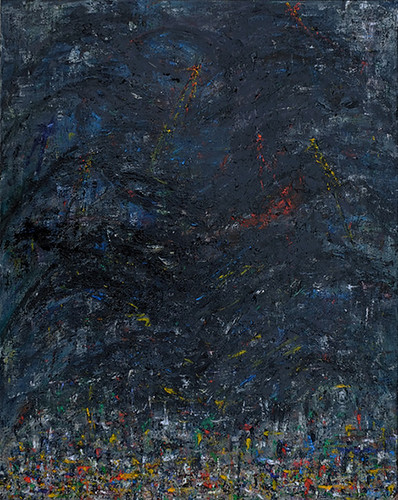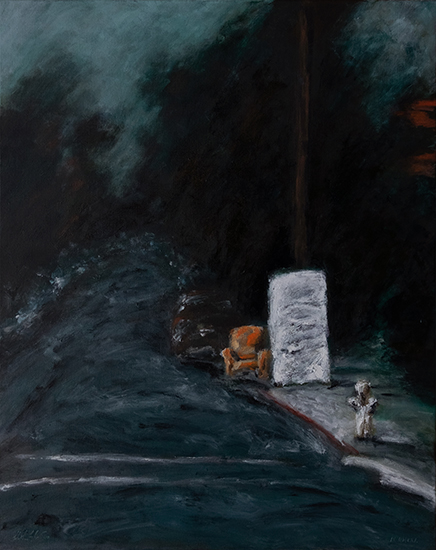College Town was a snapshot of the unpretentious college city I live in, during the summertime when droves of young temporary dwellers cleared out their flats and moved on to their next destination, or back to where they came from, and left their transitory possessions at the curbs for repurposing. This still image captured the melancholic and slightly forlorn atmosphere after the adrenaline rush from graduation celebrations, when the excitement had ended and only abandoned chairs and mattresses scattered about in this way station, which dutifully quietly welcomed and sent off the young people to make their great or tiny marks to the world, year after year.
Category Archives: City
Featured Painting – New Century’s Shangri-La
My recently painting New Century’s Shangri-La is rather visually intriguing — a colorful and orderly semi-abstract landscape/cityscape, serene and paradisal, being menaced by heavy dark storms swirling above, which threaten to crush down at any moment and bring havoc to the orderly world below. The ironic title unfortunately aptly described the state of our world, if not yet today, soon tomorrow.

New Century’s Shangri-La
Oil on Canvas
30″ x 24″
Completed in 2017
Featured Painting: “Net” – A Gloomy Urban Snapshot
My 2003 oil painting Net, currently exhibiting at the McGuire Real Estate gallery in Berkeley as part of the “Crowded by Beauty” exhibit, is a study of alienation and anxiety of our time. The vertical canvas is split unevenly into three narrow stripes – a bright and somewhat richly patterned center “panel”, flanked by two darker and simpler outer “panels”; with the slanting perspectives of the outer panels, the whole image resembles an opened-up triptych. Furthermore, the center panel was covered by repeating yet subtly varied outlines of small windows and some interlocking ladders, which tilt in various degrees; the joyless left panel is a simple building façade, immobile, and featureless, except for some blank windows; the right panel features one large window, and behind the casually divided glass panes, there is a broadly sketched sad-looking man, looking out, tentatively raises his hands, as if attempting to make gestures of hesitant acknowledgement.
The strong contrast of the three panels, with the vivid and colorful middle, and somber and austere at the sides, plus the alien-looking ghostly person locked inside his flat, captures a sense of dislocation and disjointedness quite well.

Net
Oil on Canvas
30″ x 24″
Completed in 2003
Not a surprise for a painting created at a sad moment of history – it was done in the year when George W. Bush poised to invade Iraq in spite of the fierce and sound oppositions from virtually every corner of the globe. My painting managed to capture the Zeitgeist then; unfortunately, the overall mood still fits today’s gloomy atmosphere.
Dichotomic “In Distant Country”
One of my paintings selected in a recent exhibition at Berkeley Central Arts Passage, Today’s Artists Interact with Major Art Movements from the Renaissance to the Present, is a painting of part cityscape and part animal figure study.

In Distant Country / 在遙遠的国度 / In fernem Land
Oil on Canvas
22″ x 28″
Completed in 2011
The left side of the painting, in shades of washed-out gray, depicts the Old St. John’s Hospital, an 11th-century hospital in Bruges, Belgium while the right side zooms in one of the omnipresent swans and the symbol of that ancient city, painted in intensely saturated rich hues. I conceived this painting while visiting Bruges, when I was quite intrigued and even moved by the stark contrast of immobile and somewhat faded history and threadbare nobility, and the living creatures full of grace, energy and slight menace.
Furthermore, I named this title to ensure that the German title In fernem Land is the first line of the most celebrated aria by the title character in Wagner’s opera Lohengrin, a mysterious knight arrived in a boat drawn by a swan, narrating his mythical original and his frustrated hope by lacking of faith he demanded from a woman he loved and rescued, whose child-ruler brother was turned into that swan and his disappearance had triggered a chain of events.
The medieval building and the medieval story interwoven, the purity and menace of this lofty bird, along with the historical baggage of Wagner, conspire to add extra meanings to this rather deceptively simply painting.

